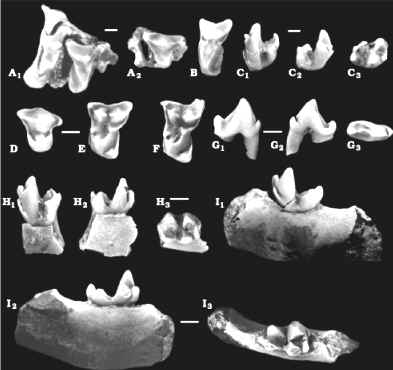 Palaeoryctidae: Didelphodus, Gelastops, Palaeoryctes.
Palaeoryctidae: Didelphodus, Gelastops, Palaeoryctes.| Eutheria | ||
| The Vertebrates | Placentalia |
| Vertebrates Home | Vertebrate | Vertebrate |
|
Abbreviated Dendrogram
Mammalia
├─Metatheria
└─Eutheria
└─┬─Eomaia
└─┬─Zhelestidae
└─┬─Asioryctitheria
└─┬─Zalambdalestidae
└─┬─Leptictida
├─Palaeoryctidae
│ └?─"Cimolesta"
└─┬─┬─?Purgatorius
│ └─┬─Protungulatum
│ └─Oxyprimus
└─Crown Group Placentalia
├─Boreoeutheria
├─┬─Laurasiatheria
│ └─Euarchontoglires
├─Afrotheria
└─Xenarthra
|
Contents
Overview |
Taxa on This Page
 Palaeoryctidae: Didelphodus, Gelastops, Palaeoryctes.
Palaeoryctidae: Didelphodus, Gelastops, Palaeoryctes.
Range: Late Cretaceous (Maastrichtian) to Middle Eocene Lutetian) of Europe, Africa & North America.
Phylogeny:
As insectivores: Soricomorpha: (Tenrecoidea + Solenodontidae + (Talpoidea + Soricoidea))) + *.
As stem placentals: Apomorphic Placentals : Leptictida + (Protungulatum + Crown Group Placentalia) + * (may be related to "Cimolesta"?)
Characters: maxilla broadly contacting frontal [MN93]; "small facial expansion of the lacrimal [MN93]; petrotympanic fissure present [MN93]; medial wall of auditory bulla present, constructed from expanded rostral process (=? tympanic crest) of petrosal [MN93] [A+02$]; mastoid fused with tympanohyal [MN93]; piriform fenestra present [MN93]; ossified entotympanic comprising at least part of tympanic floor [A+02$]; p4 not molariform [A+02$]; upper molars transversely wide, with wide stylar shelf and large parastylar area; metacone prominent [A+02]; paracone & metacone high & connate at the base [A+02$]; protocone anteriorly recumbent; trigonids tall; paraconid small on lowers; notch near paraconid accommodates talonid of next mesial tooth [A+02$]; talonid basin broad [A+02].
Image: teeth of Pararyctes rutherfordi from www.paleo.pan.pl/acta/acta47/app47-691.pdf (former page) ATW030731
Comments: archaic group of insectivore-like forms. From a near-complete skull of the genus Palaeoryctes found in New Mexico, it is known that palaeoryctids were small, shrew-like insectivores with an elongated snout similar to that of the Lepticids. However, in contrast to the latter, little is known about palaeoryctids postcranial anatomy. Where the leptictids were short-lived, the paleoryctids seem to have been ancestors of Eocene species. While their dental morphology still indicate a mostly insectivorous diet, it, to some extent, relates to Eocene carnivores such as creodonts (Agusti & Anton 2002). Palaeoryctes from the Middle to Late Palaeocene of North America, was around 12.5 centimetres (4.9 in) long, and weighed around 20 to 60 grams. The relationship between this and other insectivorous mammals is uncertain (Gingerich 1982). Palaeoryctidae was originally assigned to the now-abandoned grouping Insectivora by Sloan and Van Valen (1965) and more recently to Eutheria by Scott et al. (2002). Wikipedia MAK111210
Links: Palaeoryctidae Mikko's Phylogeny); MESOZOIC MAMMALS: Zalambdalestidae, Batodon and Cimolestidae, an internet directory (Trevor Dykes); Untitled Document abstract of JVP article); Институт проблем экологии и эволюции имени А. Н. Северцова.(Russian: abstract re new Eocene forms from Central Asia).
References: Asher et al. 2002) [A+02]; McPhee & Novacek (1993) [MN93]. ATW030731. Paleocene Mammals, Wikipedia MAK111210
Latest Cretaceous (Maastrichtian) to earliest Paleocene.
Comments: Protungulatum ('first ungulate') is an extinct genus of mammal first found in the Bug Creek Anthills in northeastern Montana. The Bug Creek Anthills were initially believed to be Late Cretaceous (latest maastrichtian) because of the presence of the remains of non-avian dinosaurs and common Cretaceous mammals, but these were later shown to have been reworked from Late Cretaceous strata, and the Bug Creek Anthills are currently believed to be Early Paleocene (Puercan) in age. Remains from the Ravenscrag Formation of Saskatchewan, Canada have been assigned to P. donnae. These remains may also be Cretaceous in age, but the age of the Ravenscrag Formation is not entirely certain [ref]. In 2011, remains of a new species of Protungulatum, P. coombsi, from the Hell Creek Formation, which is definitely Late Cretaceous (Maastrichtian) in age, proved that Protungulatum was present in both the Cretaceous and the Paleocene (Archibald et al. (2011)). It was initially assignd to the order condylarthra, a group of archaic "ungulates", that is now known to be polyphyletic. According to Wible et al. 2009 and Archibald et al. (2011), Protungulatum is not even definitely a placental. - from Wikipedia
Phylogeny: Apomorphic Placentals : Leptictida + Palaeoryctidae + (Crown Group Placentalia + * )
from the Paleocene.
Phylogeny: Apomorphic Placentals : Leptictida + Palaeoryctidae + (Protungulatum + * : : Boreoeutheria + Afrotheria + Xenarthra)
Comments: Current molecular phylogeny supports a near-simultaneous origin of crown placentals, although cladistic analysis using Asian and Amerucan Cretaceous taxa supports a norther origin (Boreoeutheria). . The fact that no South American Cretaceous Eutharians are known also argues against the Epitheria hypothesis.
Epitheria are defined by the apomorphy Stirrup-shaped stapes, which are absent in xenarthra, although could simply be a reversal. See The origin of Placental Mammals discussion for more MAK111208
Links: Basal Epitheria.
Boreoeutheria : Laurasian placentals
from the Paleocene.
Comments: No morphological features, based on molecular phylogeny only. See The origin of Placental Mammals. However, cladistic analysis by Wible et al. 2007 and 2009 do not recover a monophyletic Boreoeutheria. MAK120713
Links checked ATW051011